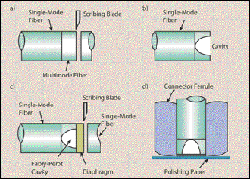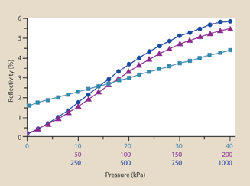
All-SiO2 Fiber Pressure Sensor Sets Sensitivity Record
Breck Hitz
By fabricating a miniature Fabry-Perot interferometer on the tip of a single-mode fiber, researchers at the University of Maribor in Slovenia have created a pressure sensor that they believe is two orders of magnitude more sensitive than any previously reported all-SiO2 device. All-SiO2 construction is desirable because it has proved to be robust and stable in many environments.

Figure 1. A tiny Fabry-Perot interferometer is created at the end of the single-mode fiber. When the local pressure changes, the diaphragm deflects, and the interferometer's reflectivity changes. Images ©OSA.
The device consists of a thin SiO2 diaphragm fused over a small cavity at the end of a single-mode fiber (Figure 1). A Fabry-Perot interferometer is formed between the concave surface of the cavity and the diaphragm, and its reflectivity changes when local pressure variations deflect the diaphragm.
The key to fabricating the sensor is ultrafine control over the thickness of the diaphragm, which allows the sensitivity to be set to almost any desired pressure range. The first fabrication step is to splice a multimode fiber with a 62.5-µm core to a single-mode fiber. The researchers accomplish this with standard techniques for fusing two multimode fibers. They cleave the multimode fiber about 40 &µm from the splice (Figure 2a), then expose the face of the multimode fiber to a hydrofluoric acid (HF) etching process.

Figure 2. Fabrication of the interferometer involves several steps. After the diaphragm is polished to a thickness of several microns, a chemical etching process further tunes its thickness.
The HF etch rate of the germanium-doped core of the multimode fiber is about 10 times that of the surrounding cladding, forming a cavity in the center of the multimode fiber (Figure 2b). After etching the cavity, the researchers splice a second single-mode fiber onto the etched multimode fiber and cleave it about 10 to 50 µm from the splice (Figure 2c). Finally, they polish the single-mode fiber -- now the diaphragm -- to a thickness of perhaps 3 to 5 µm (Figure 2d).
Even when polished to several microns, however, the diaphragm is not thin enough for the measurement of low pressures. They tune the precise diaphragm thickness by exposing it to another HF etching process, buffering the HF with NH4F so that the germanium core is etched more slowly than the cladding. Without the buffering, a hole would have been etched in the center of the diaphragm.

Figure 3. Three different sensors -- with different diaphragm thicknesses -- measured pressure in various ranges. The most sensitive, 0 to 40 kPa, is of interest for many biomedical applications.
They place the sensor in a pressure chamber as they etch the diaphragm, cycle the pressure in the chamber and monitor the reflectivity from the Fabry-Perot. They halt the etching process when the variation of the reflected signal reaches a satisfactory level.
The researchers have fabricated sensors with various diaphragm thicknesses and have demonstrated their measurement capabilities in various pressure ranges (Figure 3). The most sensitive sensor, designed to operate in the biomedically interesting range of tens of kilopascals, achieved an optical phase change of ~1.1 rad at 40 kPa, corresponding to a diaphragm deflection of 3.4 nm/kPa. In comparison, the highest previously reported deflection was 0.04 nm/kPa.
Published: September 2005